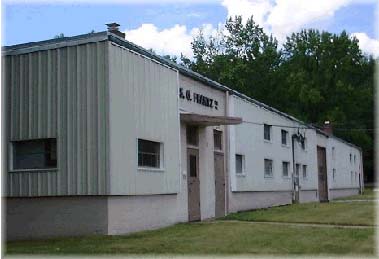

The Company
was founded by Samuel G. Frantz in 1935, and incorporated in New York
in 1940. Business and manufacturing operations were carried out in New
York City until 1950, when they were moved to a new plant in Lawrence
Township, New Jersey. This building, enlarged in 1956, still houses
business and manufacturing operations.
The Company
specializes in the design and manufacture of magnetic separation equipment.
During the life of Samuel Frantz, all of its products were based on
his inventions. The principal product lines which he developed are solenoidal
high gradient electromagnetic separators for removing fine ferromagnetic
particles from fluids and dry materials, permanent magnet separators
similar in design (both sold under the trademark FerroFilter®),
and a laboratory unit for separating components of samples of minerals
according to susceptibility (sold under the trademark Isodynamic®).
Broad patents covering the laboratory separator and the solenoidal high
gradient separators were issued to Frantz in 1936 and 1937, respectively.
The principal
initial market for the Company's lines of FerroFilter®
magnetic separators was the ceramic industry, which still uses them
to remove ferromagnetic contamination from clays (slurries, slips and
dry powders), frits and glazes. During Frantz's life, markets were expanded
to include applications for purifying pigments, foods, chemicals and
pharmaceutical products. The FerroFilter® lines became
well known and established as standard equipment for such applications
in substantially all of the industrialized countries of the world.
By 1971 the
Isodynamic® separator was in use in virtually every leading
mineralogical laboratory in the world with the exception of those in
the Soviet Union and China, and possibly some laboratories in England
and Commonwealth countries.
During Frantz's
life applications for FerroFilter® permanent magnet separators
in the magnetic filtration of lubricating oils and hydraulic fluids
were well established. Major O.E.M. customers were manufacturers of
heavy duty, high pressure pumps for oil well service. Units, which provided
combined magnetic filtration and mechanical straining, were also used
in applications similar to those for which electromagnetic separators
were used, either for reasons of economy or to reduce explosion hazard.
During the
last years of his life, Frantz worked with a major kaolin producer to
develop a method for removing fine paramagnetic contaminating particles
from the product to improve its brightness and whiteness. Large high
intensity, high gradient magnetic separators used in the industry today
were the result of this work, plus further development.
During the
1970's and 1980's, the Company's lines of FerroFilter®
electromagnetic separators for processing fluids were substantially
expanded by increased processing capacity, temperature, and pressure;
adding ASME code pressure vessels to some models; and adding models
with 2,500 Gauss background field (Series F2). More recently, series
F1E models have been added with 1,500 Gauss background field, which
is intermediate between the series F2 and the original series F1 separators.
The F1E series provides greater economy, while both the series F1E and
F2 provide better magnetic separation under difficult processing conditions.
Systems designed for automatic cleaning have been manufactured for many
years. Frantz has also designed and manufactured high intensity, high
gradient solenoidal separators with matrices. These units produce magnetic
fields up to 20,000 Gauss.
Improvements
in the line of FerroFilter® electromagnetic separators
for processing dry materials during the 70's and 80's were modifications
to adapt them to applications requiring clean conditions (such as pharmaceutical
products), high product temperatures, and large-scale production with
automated operating and cleaning cycles. More recently series F2 separators
for dry materials have been made available. Other improvements have
been made to improve substantially the effectiveness of magnetic separation
of fine, flowable powders.
Improvements
in the FerroFilter® magnetic separators powered by permanent
magnets have included higher processing capacity and higher pressure.
More recently units are being designed to utilize rare earth magnets
for processing both wet and dry materials.
Efforts to
improve and expand the Company's products for mineralogical investigation,
begun in 1972, have been highly successful. Based on the patent, the
Barrier separator (Model LB-1) provides magnetic energy gradient, or
force on particles of a given susceptibility, more than three times
greater than the force available in the Isodynamic® separator.
This gives it capability for separating minerals of susceptibilities
much weaker than those that can be separated by the Isodynamic®
separator and, with improvements in particle feed and travel systems,
quality of separations is substantially improved and processing times
are much reduced. The LB-1 is capable of exploiting differences in diamagnetic
susceptibility to separate – for example, relatively pure zircon
or diamond crystals from others containing slight impurities. Beginning
with highly effective applications at U.S. Geological Survey agencies
(NIST), the barrier is now used in many mineralogical facilities worldwide.
Complete units as well as retrofit kits for the older model L-1 Isodynamic®
separators are being sold.
An accessory
device (Model LFC-2 Low Field Control) has also been developed for use
with either the Isodynamic® or the Barrier separator
to give them the capability for separating ferromagnetic materials according
to differences in their magnetic properties, a separation which Frantz
considered more difficult than any other.
Research and
development are ongoing processes at Frantz. Continuous efforts yield
improvements to both industrial and laboratory equipment, enhancing
separations that have been successfully performed in the past, and opening
new applications. A recently granted patent for “Method and Apparatus
for Making Continuous Magnetic Separations” discloses principles
underlying new equipment development.
Applications
for the industrial units have been broadened. Uses in the chemical,
food, pigment, paint and other processing industries have expanded into
many new areas. Numerous successful applications in new processing industries
have been developed, such as ink producers, who have come to depend
on Frantz industrial magnetic separators. Series F2 units have further
broadened applications by providing better separations under more difficult
processing conditions, for example, in ceramics (including those used
for electronic applications), frits, pigments and pharmaceuticals. Seeking
and investigating new applications are continuing processes at Frantz.
|